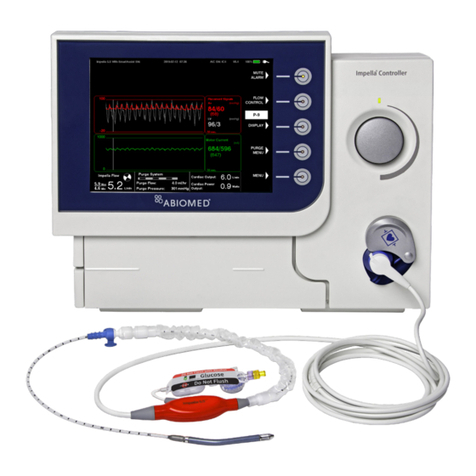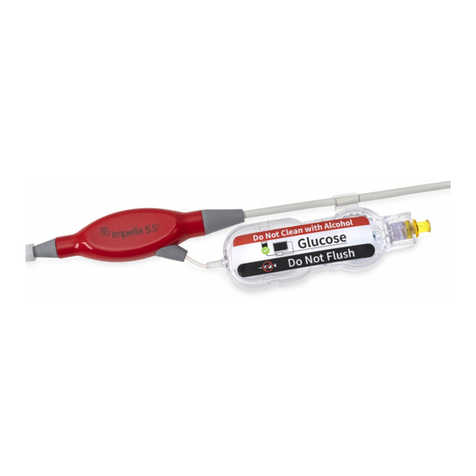
TABLE OF CONTENTS
FIGURES
Figure 3.1 Impella®Catheter in the Heart................................................. 3.1
Figure 3.2a Set-up Configuration of the Automated Impella®Controller,
Impella® 2.5 or Impella CP®Catheter, and Accessories
(Impella CP®shown)................................................................ 3.3
Figure 3.2b Standard Configuration of the Automated Impella®Controller,
Impella®2.5 or Impella CP®Catheter, and Accessories
(Impella CP®shown)................................................................ 3.3
Figure 3.3 Set-up Configuration of the Automated Impella®Controller,
Impella®5.0 or LD Catheter, and Accessories
(Impella®5.0 shown) ............................................................... 3.4
Figure 3.4 Impella®Catheters................................................................... 3.5
Figure 3.5 Impella®5.0 and LD Differential Pressure Sensor
(Impella®5.0 shown) ............................................................... 3.9
Figure 3.6 Electrical Signal Generated by the Cardiac Cycle ...................... 3.9
Figure 3.7 Correct Impella®5.0/LD Catheter Positioning and Pulsatile
Placement Signal ..................................................................... 3.10
Figure 3.8 Incorrect Impella®5.0/LD Catheter Positioning and Flat
Placement Signal ..................................................................... 3.10
Figure 3.9 Automated Impella®Controller – Front View ........................... 3.11
Figure 3.10 Purge Cassette ........................................................................ 3.12
Figure 3.11 White Connector Cable............................................................ 3.14
Figure 3.12 Impella®2.5 Introducer Kit ...................................................... 3.14
Figure 3.13 Impella CP®Introducer Kit ....................................................... 3.14
Figure 3.14 Silicone Plugs (Impella®5.0/LD) ............................................... 3.14
Figure 3.15 Impella®Axillary Insertion Kit
(Impella®2.5, 5.0, and Impella CP®)........................................ 3.15
Figure 3.16 Placement Guidewire............................................................... 3.15
Figure 3.17 Dextrose Solution .................................................................... 3.15
Figure 3.18 Automated Impella®Controller Cart ........................................ 3.15
Figure 4.1 Automated Impella®Controller Features – Front View............. 4.2
Figure 4.2 Automated Impella®Controller Features – Side Views............. 4.4
Figure 4.3 Home Screen ........................................................................... 4.6
Figure 4.4 Placement Screen..................................................................... 4.9
Figure 4.5 Purge Screen............................................................................ 4.10
Figure 4.6 Infusion History Screen ............................................................ 4.12
Figure 5.1 Automated Impella®Controller Power Switch .......................... 5.3
Figure 5.2 Automated Impella®Controller Startup Screen ........................ 5.4
Figure 5.3 Initial Case Start Screen........................................................... 5.5
Figure 5.4 Inserting Purge Cassette into Automated Impella®Controller .. 5.6
Figure 5.5 Inserting the Catheter Plug into the Connector Cable .............. 5.7
Figure 5.6 Snapping Plastic Clip to Connector Cable
(Impella CP®shown) .................................................................5.7
Figure 5.7 Priming the Impella Purge Lumen............................................. 5.8
Figure 5.8 Connecting the Luer(s) to the Impella®Catheter
(Impella CP®shown)................................................................ 5.8
Figure 5.9 Priming the Placement Signal Lumen ....................................... 5.9
Figure 5.10 Squeezing the White Flush Valve to Prime the Placement
Signal Lumen........................................................................... 5.9
Figure 5.11 Entering Purge Fluid Information.............................................. 5.10
Figure 5.12 Connecting the Purge Tubing to the Connector Cable.............. 5.11
Figure 5.13 Set-up Configuration of the Impella®System
(Impella CP®shown)................................................................ 5.11
Figure 5.14 Inserting the Peel-Away Introducer.......................................... 5.12
Figure 5.15 Inserting the Diagnostic Catheter............................................. 5.13
Figure 5.16 Loading the Catheter on the Guidewire using the
EasyGuide Lumen .................................................................... 5.13
Figure 5.17 Loading the Catheter on the Guidewire without the
EasyGuide Lumen and Aligning the Placement Guidewire........ 5.14
Figure 5.18 Inserting the Impella®Catheter................................................ 5.15
Figure 5.19 Aortic Waveform on Placement Signal Screen .......................... 5.15
Figure 5.20 Inserting the Peel-Away Introducer.......................................... 5.17
Figure 5.21 Inserting the Diagnostic Catheter............................................. 5.18
Figure 5.22 Loading the Catheter on the Guidewire using the
EasyGuide Lumen .................................................................... 5.18
Figure 5.23 Loading the Catheter on the Guidewire without the
EasyGuide Lumen and Aligning the Placement Guidewire........ 5.19
Figure 5.24 Inserting the Impella®Catheter................................................ 5.20
Figure 5.25 Aortic Waveform on Placement Screen..................................... 5.20
Figure 5.26 Introducer, Graft Lock, and Hemashield Platinum Graft
(Graft Not Supplied)................................................................. 5.22
Figure 5.27 Correct Positioning If Second Graft Lock Required ................... 5.22
Figure 5.28 Closing the Graft Lock ............................................................. 5.23
Figure 5.29 Releasing the Graft Lock.......................................................... 5.24
Figure 5.30 Cut-Down Insertion of the Impella®5.0 Catheter..................... 5.25
Figure 5.31 Guidewire Placement............................................................... 5.26
Figure 5.32 Femoral Artery Insertion of the Impella®5.0 Catheter Using
a Sidearm Graft ....................................................................... 5.27
Figure 5.33 Impella®LD Catheter with Silicone Plugs ................................. 5.30
Figure 5.34 Waveform as Catheter is Advanced into the Aorta................... 5.30
Figure 5.35 Pulsatile Waveform on Placement Signal Screen....................... 5.31
Figure 5.36 Starting the Impella®2.5 and Impella CP®Catheter................. 5.32
Figure 5.37 FLOW CONTROL Options for the Impella®2.5 and
Impella CP® Catheter ............................................................... 5.32
Figure 5.38 Ventricular Waveform on Placement Signal Screen................... 5.33
Figure 5.39 Transfer to P-level Mode.......................................................... 5.33
Figure 5.40 Adjusting P-level...................................................................... 5.35
Figure 5.41 Removing the Peel-Away Introducer (14 Fr Introducer shown).. 5.35
Figure 5.42 Standard Configuration for Impella®System after Transfer
from the Set-up Configuration ................................................. 5.37
Figure 5.43 Waveform as Catheter is Advanced into the Aorta ................... 5.38
Figure 5.44 Pulsatile Waveform on Placement Screen................................. 5.39
Figure 5.45 Selecting P-level ...................................................................... 5.39
Figure 5.46 Confirming Placement on the Placement Signal Screen ............ 5.40
Figure 5.47 Selecting P-Level...................................................................... 5.41
Figure 5.48 Confirming Placement on the Placement Signal Screen ............ 5.42
Figure 5.49 Impella®LD Catheter After Implantation.................................. 5.43
Figure 5.50 Disconnecting the Y Connector from the Purge Cassette
Tubing ..................................................................................... 5.45
Figure 5.51 Removing the Stylet................................................................. 5.50
Figure 5.52 Inserting the Guidewire with the Cheater................................. 5.51
Figure 5.53 Loosening the Tuohy-Borst Valve............................................. 5.51
Figure 6.1 Kaplan-Meier Survival Curves Survival (to 30 days) for the ISAR-
SHOCK Trial ............................................................................. 6.4
Figure 6.2 Lactate Levels Seen Post-Implant During the Trial .................... 6.5
Figure 6.3 Increase in Cardiac Index from Baseline, Impella vs. IABP 30
Minutes Post-Support, in Patients Treated for Cardiogenic Shock
After an AMI (ISAR-SHOCK)..................................................... 6.5
Figure 6.4 Change in Inotropic Dosage at 24 Hours, Impella vs. IABP
in Patients Treated for Cardiogenic Shock After an AMI
(ISAR-SHOCK) ......................................................................... 6.6
Figure 6.5 Time Intervals for Impella Implants Data Collection by Type of
Device ..................................................................................... 6.8
Figure 6.6 Kaplan-Meier Curve Estimates for 30 Day Survival - All Patient
Cohort .................................................................................... 6.9
Figure 6.7 Kaplan-Meier Curve Estimates for 30 Day Survival (by Device) - All
Patient Cohort ........................................................................ 6.9
Figure 6.8 Outcomes Between Impella Registry Subgroups: Patients Likely to
be Eligible for RCTs vs. Patients Likely to be Excluded from RCTs
(“Salvage” Patients) ................................................................ 6.10
Figure 6.9 30-Day Outcomes (by Device) Between Impella Registry Subgroups:
Patients Likely to be Eligible for RCTs vs. Patients Likely to be
Excluded from RCTs (“Salvage” Patients)................................. 6.11


































